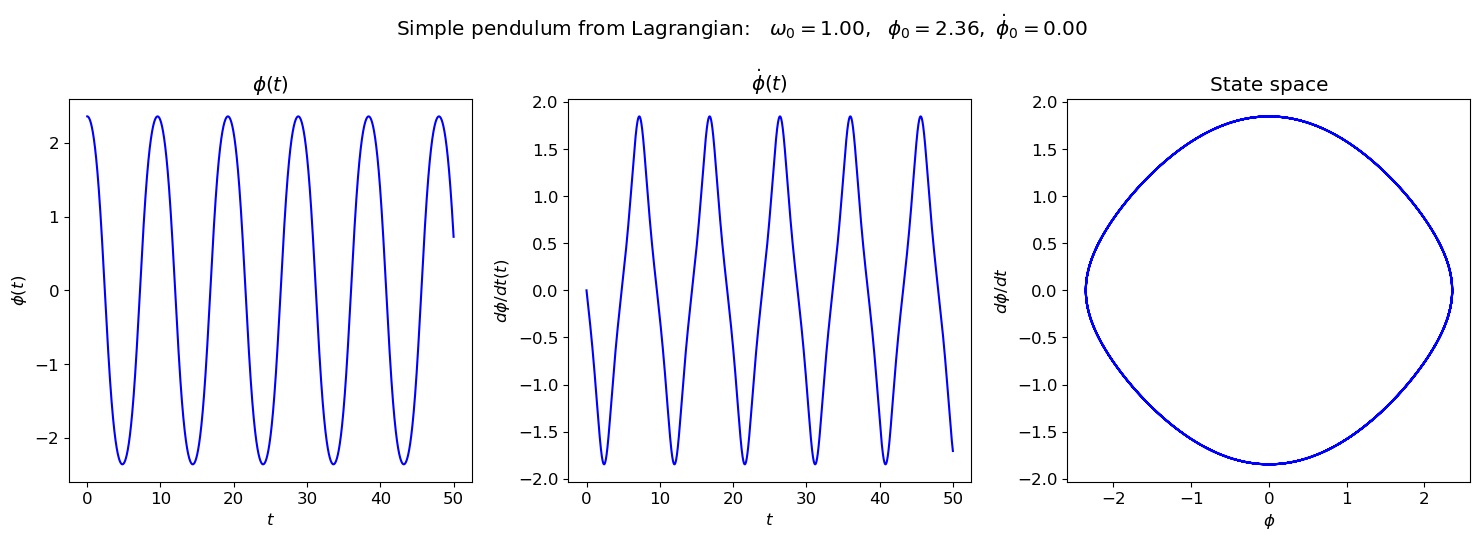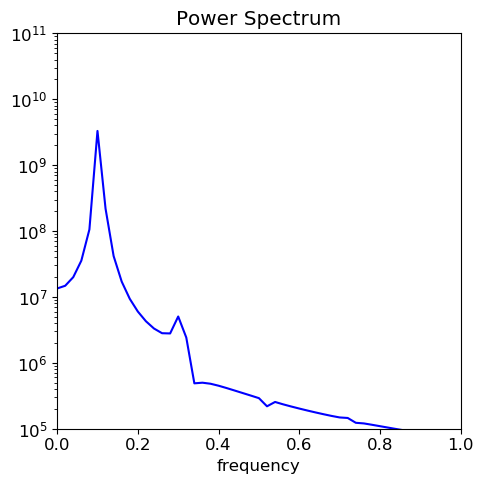Simple pendulum using Lagrange’s equation
Contents
Simple pendulum using Lagrange’s equation#
Defines a LagrangianPendulum class that is used to generate basic pendulum plots from solving Lagrange’s equations.
Last revised 17-Mar-2019 by Dick Furnstahl (furnstahl.1@osu.edu).
Euler-Lagrange equation#
For a simple pendulum, the Lagrangian with generalized coordinate \(\phi\) is
\(\begin{align} \mathcal{L} = \frac12 m L^2 \dot\phi^2 - mgL(1 - \cos\phi) \end{align}\)
The Euler-Lagrange equation is
\(\begin{align} \frac{d}{dt}\frac{\partial\mathcal{L}}{\partial \dot\phi} = \frac{\partial\mathcal L}{\partial\phi} \quad\Longrightarrow\quad m L^2 \ddot \phi = -mgL\sin\phi \ \mbox{or}\ \ddot\phi = - \omega_0^2\sin\phi = 0 \;. \end{align}\)
Hamilton’s equations#
The generalized momentum corresponding to \(\phi\) is
\(\begin{align} \frac{\partial\mathcal{L}}{\partial \dot\phi} = m L^2 \dot\phi \equiv p_\phi \;. \end{align}\)
We can invert this equation to find \(\dot\phi = p_\phi / m L^2\). Constructing the Hamiltonian by Legendre transformation we find
\(\begin{align} \mathcal{H} &= \dot\phi p_\phi - \mathcal{L} \\ &= \frac{p_\phi^2}{m L^2} - \frac12 m L^2 \dot\phi^2 + mgL(1 - \cos\phi) \\ &= \frac{p_\phi^2}{2 m L^2} + mgL(1 - \cos\phi) \;. \end{align}\)
Thus \(\mathcal{H}\) is simply \(T + V\). Hamilton’s equations are
\(\begin{align} \dot\phi &= \frac{\partial\mathcal{H}}{\partial p_\phi} = \frac{p_\phi}{m L^2} \\ \dot p_\phi &= -\frac{\partial\mathcal{H}}{\partial \phi} = -mgL \sin\phi \;. \end{align}\)
%matplotlib inline
import numpy as np
from scipy.integrate import odeint, solve_ivp
import matplotlib.pyplot as plt
# The dpi (dots-per-inch) setting will affect the resolution and how large
# the plots appear on screen and printed. So you may want/need to adjust
# the figsize when creating the figure.
plt.rcParams['figure.dpi'] = 100. # this is the default for notebook
# Change the common font size (smaller when higher dpi)
font_size = 12
plt.rcParams.update({'font.size': font_size})
Pendulum class and utility functions#
class LagrangianPendulum():
"""
Pendulum class implements the parameters and Lagrange's equations for
a simple pendulum (no driving or damping).
Parameters
----------
L : float
length of the simple pendulum
g : float
gravitational acceleration at the earth's surface
omega_0 : float
natural frequency of the pendulum (\sqrt{g/l} where l is the
pendulum length)
mass : float
mass of pendulum
Methods
-------
dy_dt(t, y)
Returns the right side of the differential equation in vector y,
given time t and the corresponding value of y.
"""
def __init__(self, L=1., mass=1., g=1.
):
self.L = L
self.g = g
self.omega_0 = np.sqrt(g/L)
self.mass = mass
def dy_dt(self, t, y):
"""
This function returns the right-hand side of the diffeq:
[dphi/dt d^2phi/dt^2]
Parameters
----------
t : float
time
y : float
A 2-component vector with y[0] = phi(t) and y[1] = dphi/dt
Returns
-------
"""
return [y[1], -self.omega_0**2 * np.sin(y[0]) ]
def solve_ode(self, t_pts, phi_0, phi_dot_0,
abserr=1.0e-9, relerr=1.0e-9):
"""
Solve the ODE given initial conditions.
Specify smaller abserr and relerr to get more precision.
"""
y = [phi_0, phi_dot_0]
solution = solve_ivp(self.dy_dt, (t_pts[0], t_pts[-1]),
y, t_eval=t_pts,
atol=abserr, rtol=relerr)
phi, phi_dot = solution.y
return phi, phi_dot
def plot_y_vs_x(x, y, axis_labels=None, label=None, title=None,
color=None, linestyle=None, semilogy=False, loglog=False,
ax=None):
"""
Generic plotting function: return a figure axis with a plot of y vs. x,
with line color and style, title, axis labels, and line label
"""
if ax is None: # if the axis object doesn't exist, make one
ax = plt.gca()
if (semilogy):
line, = ax.semilogy(x, y, label=label,
color=color, linestyle=linestyle)
elif (loglog):
line, = ax.loglog(x, y, label=label,
color=color, linestyle=linestyle)
else:
line, = ax.plot(x, y, label=label,
color=color, linestyle=linestyle)
if label is not None: # if a label if passed, show the legend
ax.legend()
if title is not None: # set a title if one if passed
ax.set_title(title)
if axis_labels is not None: # set x-axis and y-axis labels if passed
ax.set_xlabel(axis_labels[0])
ax.set_ylabel(axis_labels[1])
return ax, line
def start_stop_indices(t_pts, plot_start, plot_stop):
start_index = (np.fabs(t_pts-plot_start)).argmin() # index in t_pts array
stop_index = (np.fabs(t_pts-plot_stop)).argmin() # index in t_pts array
return start_index, stop_index
Make simple pendulum plots#
# Labels for individual plot axes
phi_vs_time_labels = (r'$t$', r'$\phi(t)$')
phi_dot_vs_time_labels = (r'$t$', r'$d\phi/dt(t)$')
state_space_labels = (r'$\phi$', r'$d\phi/dt$')
# Common plotting time (generate the full time then use slices)
t_start = 0.
t_end = 50.
delta_t = 0.001
t_pts = np.arange(t_start, t_end+delta_t, delta_t)
L = 1.
g = 1.
mass = 1.
# Instantiate a pendulum
p1 = LagrangianPendulum(L=L, g=g, mass=mass)
# both plots: same initial conditions
phi_0 = (3./4.)*np.pi
phi_dot_0 = 0.
phi, phi_dot = p1.solve_ode(t_pts, phi_0, phi_dot_0)
# start the plot!
fig = plt.figure(figsize=(15,5))
overall_title = 'Simple pendulum from Lagrangian: ' + \
rf' $\omega_0 = {p1.omega_0:.2f},$' + \
rf' $\phi_0 = {phi_0:.2f},$' + \
rf' $\dot\phi_0 = {phi_dot_0:.2f}$' + \
'\n' # \n means a new line (adds some space here)
fig.suptitle(overall_title, va='baseline')
# first plot: phi plot
ax_a = fig.add_subplot(1,3,1)
start, stop = start_stop_indices(t_pts, t_start, t_end)
plot_y_vs_x(t_pts[start : stop], phi[start : stop],
axis_labels=phi_vs_time_labels,
color='blue',
label=None,
title=r'$\phi(t)$',
ax=ax_a)
# second plot: phi_dot plot
ax_b = fig.add_subplot(1,3,2)
start, stop = start_stop_indices(t_pts, t_start, t_end)
plot_y_vs_x(t_pts[start : stop], phi_dot[start : stop],
axis_labels=phi_dot_vs_time_labels,
color='blue',
label=None,
title=r'$\dot\phi(t)$',
ax=ax_b)
# third plot: state space plot from t=30 to t=50
ax_c = fig.add_subplot(1,3,3)
start, stop = start_stop_indices(t_pts, t_start, t_end)
plot_y_vs_x(phi[start : stop], phi_dot[start : stop],
axis_labels=state_space_labels,
color='blue',
label=None,
title='State space',
ax=ax_c)
fig.tight_layout()
fig.savefig('simple_pendulum_Lagrange.png', bbox_inches='tight')

Now trying the power spectrum, plotting only positive frequencies and cutting off the lower peaks:
start, stop = start_stop_indices(t_pts, t_start, t_end)
signal = phi[start:stop]
power_spectrum = np.abs(np.fft.fft(signal))**2
freqs = np.fft.fftfreq(signal.size, delta_t)
idx = np.argsort(freqs)
fig_ps = plt.figure(figsize=(5,5))
ax_ps = fig_ps.add_subplot(1,1,1)
ax_ps.semilogy(freqs[idx], power_spectrum[idx], color='blue')
ax_ps.set_xlim(0, 1.)
ax_ps.set_ylim(1.e5, 1.e11)
ax_ps.set_xlabel('frequency')
ax_ps.set_title('Power Spectrum')
fig_ps.tight_layout()

